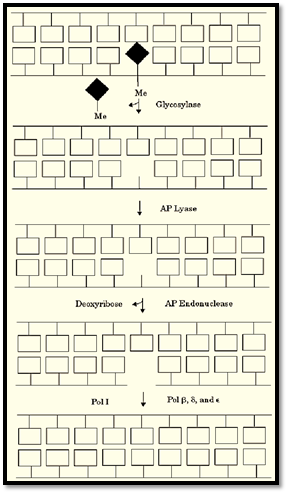


 النبات
النبات
 الحيوان
الحيوان
 الأحياء المجهرية
الأحياء المجهرية
 علم الأمراض
علم الأمراض
 التقانة الإحيائية
التقانة الإحيائية
 التقنية الحيوية المكروبية
التقنية الحيوية المكروبية
 التقنية الحياتية النانوية
التقنية الحياتية النانوية
 علم الأجنة
علم الأجنة
 الأحياء الجزيئي
الأحياء الجزيئي
 علم وظائف الأعضاء
علم وظائف الأعضاء
 الغدد
الغدد
 المضادات الحيوية
المضادات الحيوية|
Read More
Date: 28-11-2015
Date: 15-12-2015
Date: 8-5-2021
|
Base Excision Repair
Base excision repair is the DNA repair system for abnormal bases in DNA, such as uracil, hydroxymethyluracil, and hypoxanthine, and for nonbulky base modifications, such as thymine glycol and hydrates, 8-hydroxyguanine, O4-methylthymine, and 3-methyladenine (Fig. 1). The abnormal bases and simple base lesions are removed from DNA by the combined actions of DNA glycosylases (1-3) and AP (apurinic/apyrimidinic) endonucleases. The basic reaction carried out by glycosylases is the cleavage of the glycosylic bond joining the base to deoxyribose. Some of the glycosylases cleave both the glycosylic bond and the phosphodiester bond 3′ to the resulting AP site in a more or less concerted reaction. Hence, DNA glycosylases have been classified either as “pure” glycosylases or as glycosylase/AP lyases. AP endonucleases are also classified as either 3′- or 5′-AP endonucleases. All 3′-AP endonucleases are lyases that cleave the phosphodiester bond by b-elimination. The 5′-AP endonucleases carry out true hydrolysis.

Figure 1. Repair of 3-methyl adenine by base excision repair. Methyladenine DNA glycosylase cleaves the glycosylic bond of the alkylated base; this releases the alkylated base and leaves an AP site. An AP lyase and an AP endonuclease cleave 3′ and 5′, respectively, of the AP site, releasing the abasic sugar. The resulting gap is filled in by Pol I in E. coli and by Pol b or Po ld and e in humans, to produce repair patches of 1 to 10 nucleotides.
The combined actions of glycosylase, AP lyase, and AP endonuclease/exonuclease creates a one- to two-nucleotide gap in the damaged strand. This gap is filled in by DNA polymerase I in Escherichia coli, and mostly by DNA polymerase b (4) and to a lesser degree by DNA polymerases d and in yeast and humans (5). The resulting nick is ligated by DNA Ligase in E. coli, and in eukaryotes by the ligase I– (6) or ligase III–XRCC1 complex (7). Depending on the polymerase/ligase combination involved in filling in and sealing the gap, a repair patch of 1 to 10 nucleotides may be produced.
References
1.T. Lindahl (1974) Proc. Natl. Acad. Sci. USA 71, 3649–3653.
2.T. Lindahl (1976) Nature 259, 64–66.
3.J. Laval (1977) Nature 269, 828–832.
4.R. W. Sobol, J. K. Horton, R. Kohn, H. Gu, R. K. Singhal, R. Prasad, K. Rajewsky, and S. H. Wilson (1996) Nature 379, 183–186.
5. Z. Wang, X. Wu, and E. C. Friedberg (1993) Mol. Cell. Biol. 13, 1051–1058.
6.R. Prasad, R. K. Singhal, D. K. Srivastava, J. T. Molina, A. E. Tomkinson, and S. H. Wilson (1996) J. Biol. Chem. 271, 16000–16007.
7.K. W. Caldecott, C. K. McKeown, J. D. Tucker, S. Ljungquist, and L. H. Thompson (1994) Mol. Cell. Biol. 14, 68–76.



|
|
|
|
صنع الذكريات والتفكير يدمر الدماغ.. دراسة تشرح السبب
|
|
|
|
|
|
|
الصين.. عودة كاسحتي الجليد إلى شنغهاي بعد انتهاء بعثة استكشافية إلى القطب الجنوبي
|
|
|
|
|
|
جامعة الكفيل تكرم الفائزين بأبحاث طلبة كلية الصيدلة وطب الأسنان
|
|
|
|
مشروع التكليف الشرعي بنسخته السادسة الورود الفاطمية... أضخم حفل لفتيات كربلاء
|
|
|
|
ضمن جناح جمعيّة العميد العلميّة والفكريّة المجمع العلمي يعرض إصداراته في معرض تونس الدولي للكتاب
|
|
|
|
جامعة الكفيل تعقد مؤتمرها الطلابي العلمي الرابع
|